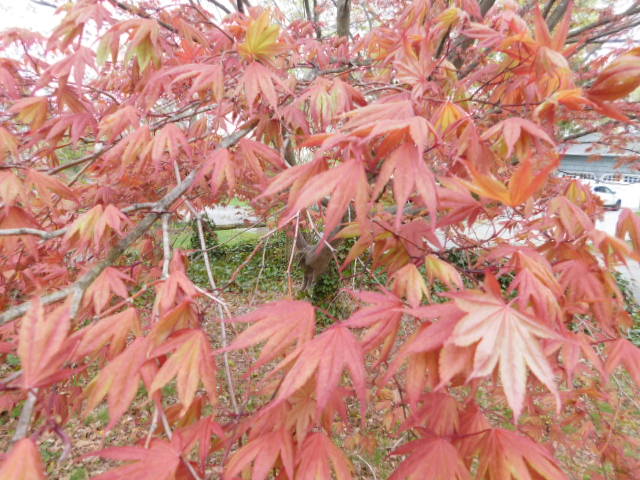 |
| Japanese maple resembles tiny artistic paper cut-outs. |
- Flowers are sublime in April, especially if it is cool so that daffodils, forsythia, and tulips can linger. Only memories of crocuses remain, but grass awakens. Yet for all that beautiful and striking activity, it is deciduous trees such as maple, oak, hickory, and beech that steal the show.
- Some trees perform full acts. Magnolia hogs any scene, except perhaps where mature cherry blossoms briefly filter clouds. Dogwood and crabapple creep forth, sometimes bursting out in the right warm microclimate. Gigantic tulip trees will soon sport blossoms that are rarely seen from below.
 |
| Sprightly baby dogwood leaves are delicious light green. |
- Have any child crayon winter and summer pictures, and you will demonstrate our innate understanding. Winter trees are brown lines, summer’s are lush green lollipops. Professional photographers and painters realize that identical vistas become entirely different. What was once exposed is hidden, what had been a jagged horizon becomes nearly smooth. It is often difficult to recognize the same place in pictures taken at different seasons.
 |
| Uncurling lilac leaves can appear almost menacing |
- Trees provide our most important spring metaphors. Apparently visibly dead for months, they suddenly burst out in frantic activity and remake themselves into the very picture of life. Except, of course, for the ones that do not, which is yet another important lesson. Everyone at one time or another hopes to be like a tree that comes back from adversity, or like a tree that can sway in the frantic vernal wind without breaking, or like an ancient but mighty oak grown from a small acorn, or simply like a reliable companion which proves that _ appearances to the contrary _ it is not over yet.
- Once leafed out , trees are exposed to danger. A late snowstorm can break branches, as can the excessively strong winds of passing weather fronts. That demonstrates how deceptively strong deciduous trees can be. We have viewed their apparently fragile skeletons for months, and are surprised that such thin frameworks support an immense waving weight. But if we think about it, much of our construction, our houses, our furniture depend on relatively light, strong. tough wood.
 |
| Linear sentinels in winter begin to soften with vernal promise. |
- I once read that there was a measurable change in global atmospheric oxygen level when the great deciduous forests of the northern landmasses leaf out in spring. I’m too lazy to verify it, but it sounds nice and might be true. Certainly on a local level these trees cut pollution, remove irritants, provide welcome shade in summer, and are generally fine things to have about.
- I could never dismiss beautiful flowers on evergreen azaleas, rhododendrons, privet, and hollies. I would not ignore the spectacular blooms on forsythias and roses. Conifers present swaths of grace all year long. But the miraculous transformation of groves of deciduous trees around Huntington in this season is a truly wondrous spectacle that I too often take for granted.
No comments:
Post a Comment